4.6: Artists Painting
- Page ID
- 231701
\( \newcommand{\vecs}[1]{\overset { \scriptstyle \rightharpoonup} {\mathbf{#1}} } \)
\( \newcommand{\vecd}[1]{\overset{-\!-\!\rightharpoonup}{\vphantom{a}\smash {#1}}} \)
\( \newcommand{\id}{\mathrm{id}}\) \( \newcommand{\Span}{\mathrm{span}}\)
( \newcommand{\kernel}{\mathrm{null}\,}\) \( \newcommand{\range}{\mathrm{range}\,}\)
\( \newcommand{\RealPart}{\mathrm{Re}}\) \( \newcommand{\ImaginaryPart}{\mathrm{Im}}\)
\( \newcommand{\Argument}{\mathrm{Arg}}\) \( \newcommand{\norm}[1]{\| #1 \|}\)
\( \newcommand{\inner}[2]{\langle #1, #2 \rangle}\)
\( \newcommand{\Span}{\mathrm{span}}\)
\( \newcommand{\id}{\mathrm{id}}\)
\( \newcommand{\Span}{\mathrm{span}}\)
\( \newcommand{\kernel}{\mathrm{null}\,}\)
\( \newcommand{\range}{\mathrm{range}\,}\)
\( \newcommand{\RealPart}{\mathrm{Re}}\)
\( \newcommand{\ImaginaryPart}{\mathrm{Im}}\)
\( \newcommand{\Argument}{\mathrm{Arg}}\)
\( \newcommand{\norm}[1]{\| #1 \|}\)
\( \newcommand{\inner}[2]{\langle #1, #2 \rangle}\)
\( \newcommand{\Span}{\mathrm{span}}\) \( \newcommand{\AA}{\unicode[.8,0]{x212B}}\)
\( \newcommand{\vectorA}[1]{\vec{#1}} % arrow\)
\( \newcommand{\vectorAt}[1]{\vec{\text{#1}}} % arrow\)
\( \newcommand{\vectorB}[1]{\overset { \scriptstyle \rightharpoonup} {\mathbf{#1}} } \)
\( \newcommand{\vectorC}[1]{\textbf{#1}} \)
\( \newcommand{\vectorD}[1]{\overrightarrow{#1}} \)
\( \newcommand{\vectorDt}[1]{\overrightarrow{\text{#1}}} \)
\( \newcommand{\vectE}[1]{\overset{-\!-\!\rightharpoonup}{\vphantom{a}\smash{\mathbf {#1}}}} \)
\( \newcommand{\vecs}[1]{\overset { \scriptstyle \rightharpoonup} {\mathbf{#1}} } \)
\( \newcommand{\vecd}[1]{\overset{-\!-\!\rightharpoonup}{\vphantom{a}\smash {#1}}} \)
\(\newcommand{\avec}{\mathbf a}\) \(\newcommand{\bvec}{\mathbf b}\) \(\newcommand{\cvec}{\mathbf c}\) \(\newcommand{\dvec}{\mathbf d}\) \(\newcommand{\dtil}{\widetilde{\mathbf d}}\) \(\newcommand{\evec}{\mathbf e}\) \(\newcommand{\fvec}{\mathbf f}\) \(\newcommand{\nvec}{\mathbf n}\) \(\newcommand{\pvec}{\mathbf p}\) \(\newcommand{\qvec}{\mathbf q}\) \(\newcommand{\svec}{\mathbf s}\) \(\newcommand{\tvec}{\mathbf t}\) \(\newcommand{\uvec}{\mathbf u}\) \(\newcommand{\vvec}{\mathbf v}\) \(\newcommand{\wvec}{\mathbf w}\) \(\newcommand{\xvec}{\mathbf x}\) \(\newcommand{\yvec}{\mathbf y}\) \(\newcommand{\zvec}{\mathbf z}\) \(\newcommand{\rvec}{\mathbf r}\) \(\newcommand{\mvec}{\mathbf m}\) \(\newcommand{\zerovec}{\mathbf 0}\) \(\newcommand{\onevec}{\mathbf 1}\) \(\newcommand{\real}{\mathbb R}\) \(\newcommand{\twovec}[2]{\left[\begin{array}{r}#1 \\ #2 \end{array}\right]}\) \(\newcommand{\ctwovec}[2]{\left[\begin{array}{c}#1 \\ #2 \end{array}\right]}\) \(\newcommand{\threevec}[3]{\left[\begin{array}{r}#1 \\ #2 \\ #3 \end{array}\right]}\) \(\newcommand{\cthreevec}[3]{\left[\begin{array}{c}#1 \\ #2 \\ #3 \end{array}\right]}\) \(\newcommand{\fourvec}[4]{\left[\begin{array}{r}#1 \\ #2 \\ #3 \\ #4 \end{array}\right]}\) \(\newcommand{\cfourvec}[4]{\left[\begin{array}{c}#1 \\ #2 \\ #3 \\ #4 \end{array}\right]}\) \(\newcommand{\fivevec}[5]{\left[\begin{array}{r}#1 \\ #2 \\ #3 \\ #4 \\ #5 \\ \end{array}\right]}\) \(\newcommand{\cfivevec}[5]{\left[\begin{array}{c}#1 \\ #2 \\ #3 \\ #4 \\ #5 \\ \end{array}\right]}\) \(\newcommand{\mattwo}[4]{\left[\begin{array}{rr}#1 \amp #2 \\ #3 \amp #4 \\ \end{array}\right]}\) \(\newcommand{\laspan}[1]{\text{Span}\{#1\}}\) \(\newcommand{\bcal}{\cal B}\) \(\newcommand{\ccal}{\cal C}\) \(\newcommand{\scal}{\cal S}\) \(\newcommand{\wcal}{\cal W}\) \(\newcommand{\ecal}{\cal E}\) \(\newcommand{\coords}[2]{\left\{#1\right\}_{#2}}\) \(\newcommand{\gray}[1]{\color{gray}{#1}}\) \(\newcommand{\lgray}[1]{\color{lightgray}{#1}}\) \(\newcommand{\rank}{\operatorname{rank}}\) \(\newcommand{\row}{\text{Row}}\) \(\newcommand{\col}{\text{Col}}\) \(\renewcommand{\row}{\text{Row}}\) \(\newcommand{\nul}{\text{Nul}}\) \(\newcommand{\var}{\text{Var}}\) \(\newcommand{\corr}{\text{corr}}\) \(\newcommand{\len}[1]{\left|#1\right|}\) \(\newcommand{\bbar}{\overline{\bvec}}\) \(\newcommand{\bhat}{\widehat{\bvec}}\) \(\newcommand{\bperp}{\bvec^\perp}\) \(\newcommand{\xhat}{\widehat{\xvec}}\) \(\newcommand{\vhat}{\widehat{\vvec}}\) \(\newcommand{\uhat}{\widehat{\uvec}}\) \(\newcommand{\what}{\widehat{\wvec}}\) \(\newcommand{\Sighat}{\widehat{\Sigma}}\) \(\newcommand{\lt}{<}\) \(\newcommand{\gt}{>}\) \(\newcommand{\amp}{&}\) \(\definecolor{fillinmathshade}{gray}{0.9}\)While our culture tends to regard easel painting as the highest form of art, this preference for painting did not pertain in colonial America. By every measure (value in probate inventories, anecdotal commentary, relative cost, number of surviving objects), colonials preferred objects that were useful as well as aesthetically pleasing. A painting and a silver teapot cost about the same, and most who had the choice opted for the teapot.
How did painting evolve over the course of the eighteenth century? How did artists learn their craft, and how did they find customers for their wares? The story is principally one of portraits and portraitists. As we have seen (see Chapter 3), some extraordinary paintings survive from the seventeenth century in the Boston area (very few appear to have been painted south of New England until the eighteenth). Portraits are an exceptional kind of painting, for, unlike other genres, they were intended for the private family and usually descended through a family line; once purchased, they had no commodity value. They performed important work within that context, memorializing the likeness of individuals, couples, and sometimes family groups. Few individuals who bought other luxury goods purchased portraits in the seventeenth century. But by the early eighteenth, an increasing number of patrons in all the colonies were willing to commission portraits, and more artists were available to satisfy this market.
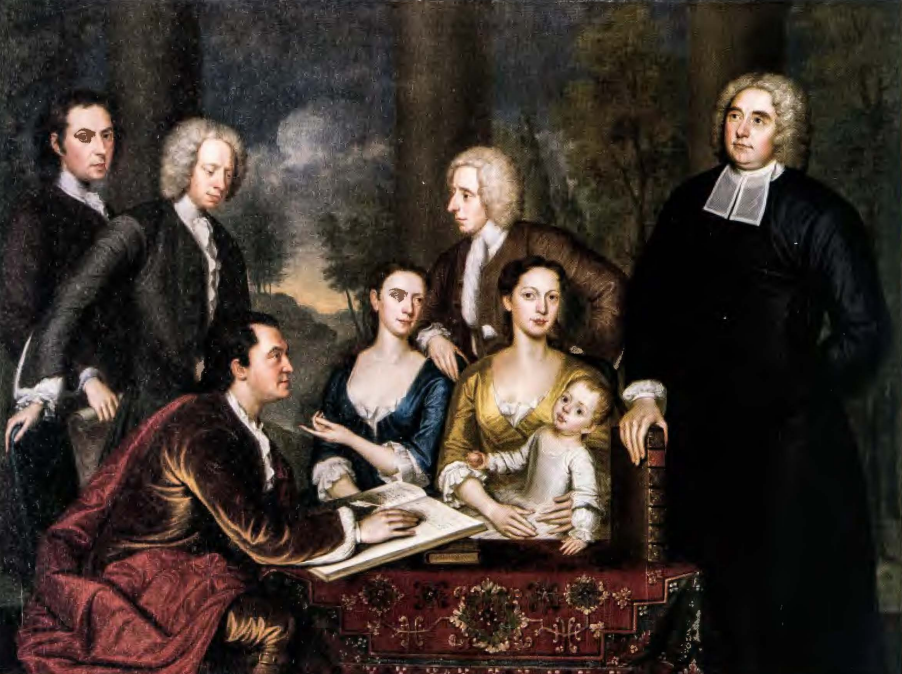
Some already accomplished painters immigrated to the colonies. The most important of these, John Smibert (1688-1751), settled in Boston in 1729. He arrived in the entourage of the philosopher George Berkeley as professor of fine art in a university Berkeley planned-he is the figure on the far right of his large painting commemorating the venture (fig. 4.29). Berkeley stands at the opposite end of the painting. Berkeley's upward gaze suggests his concern with heaven (he was a clergyman, eventually a bishop in the Church of England). His right hand, however, points downward, highlighting the expensive gilt binding of the book in his hand and the equally luxurious Turkish carpet that covers the table. The madonna-like mother and son remind the viewer of the importance of family and patrimony, while the grouping of men around the background columns suggests that they are figures of uprightness and character. The seated women-one gesturing delicately toward the distant landscape-hint at the group's larger mission: to bring civilization to the wilderness. Smibert's role in all this is to record the enterprise for posterity. His painting combines likenesses of all involved with a visual statement of their values: family, education, and property.
How did colonial artists find customers? Since there were no exhibitions and it was ungentlemanly to hang out a shop sign or advertise in the newspapers (although some did both), artists depended on reputation. An artist's reputation was created and circulated in the same milieu as the portraits: the family. Eighty percent of John Singleton Copley's several hundred colonial sitters, for instance, fit on just twenty-eight family trees. Since his identity was well known in this context, most of his colonial works are unsigned. When Copley began exhibiting in London at the Royal Academy exhibitions-open to the public and a primary place for finding new customers-he routinely signed his works, putting his name conspicuously on his achievements with an eye to bringing potential patrons to his studio.
Although Smibert and Copley are high achievers, for whom we have relatively good records and many surviving works, there are dozens of other artists about whom we know very little. Almost all of them-in both the colonial and early national (post-independence) period-were portraitists, and they worked in both the principal towns and in the countryside. Color shops provided imported pigments, canvas, and other supplies. Smibert ran such a shop in Boston, which not only gave him steady income but served to introduce his work (Dean Berkeley and His Entourage hung on the wall of the adjoining studio) to amateur artists among the gentry who were also potential patrons.
By the close of the colonial era, painters were available throughout the colonies, and even middle-class families were commissioning portraits. Education in art was random and informal, but sufficient numbers of artists acquired sufficient skill to satisfy this burgeoning demand. History paintings, with their overtones of elite education, aristocratic patronage, and theatrical didacticism, never caught on in America, but by the opening of the nineteenth century there was a blossoming of genre and landscape painting. Done on speculation and sold through middleman dealers, many of these paintings were produced by artists who had trained in newly established art academies in Philadelphia and New York or in Europe.
Copley and West: Beacon Hill and the Academy
Two important artists to emerge from colonial America John Singleton Copley (1737-1815) and Benjamin West (1738-1820)-took disparate paths from obscurity to the center of British art production in London. West and Copley not only mastered the techniques and practices emanating from London, they also revolutionized those practices.
Copley and West followed different routes to acquire training in depicting the human form. Copley's stepfather, Peter Pelham, had been a printmaker with some painting skills. When Pelham died, the thirteen-year-old Copley took over Pelham's tools and began to paint professionally. He set himself a program of study that included copying an anatomy book and Italian prints of mythological subjects, minutely observing the Bostonians around him, and drawing plaster casts of antique sculpture. The resources in Pelham's studio, together with those from Smibert's after the latter's death in 1751, were sufficient to give Copley a working knowledge of Grecian and Roman statues. Smibert's well-stocked studio, only blocks away from Copley's home, was a treasure trove of prints, drawings, and copies of Old Masters. Keen observation-Copley is known to have spent ninety hours on a single portrait gave him knowledge and the means to render bodies, faces, furniture, and fabric convincingly.
In 1765, when he was twenty-seven, Copley sent a portrait of his half-brother, Henry Pelham, to London for comment. Benjamin West, who had emigrated to London six years earlier, responded warmly and encouraged him to come abroad, to learn the European tradition and contribute to that tradition, but Copley lingered in the colonies for another decade. In Boston he produced ever more polished works, married well, and purchased five acres of property, with three houses, on Beacon Hill next to John Hancock, one of the wealthiest men in the city. His skill had brought him prosperity, but it had also clearly brought him ( as well as his customers) pleasure in the sheer power of its illusionism.
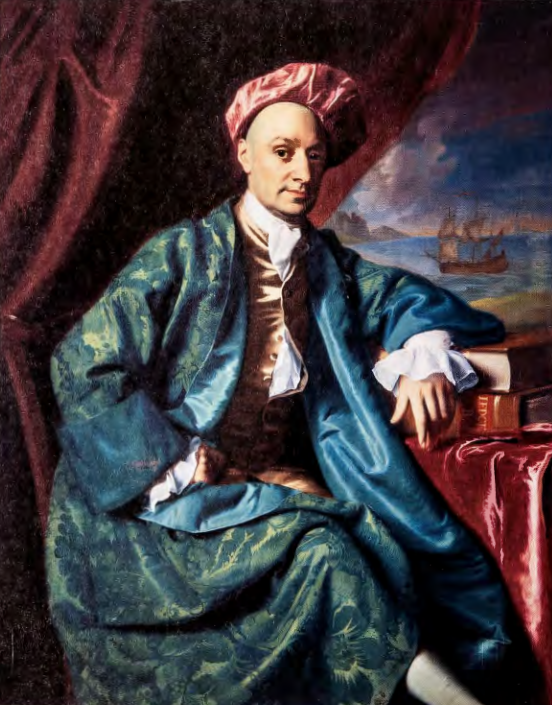
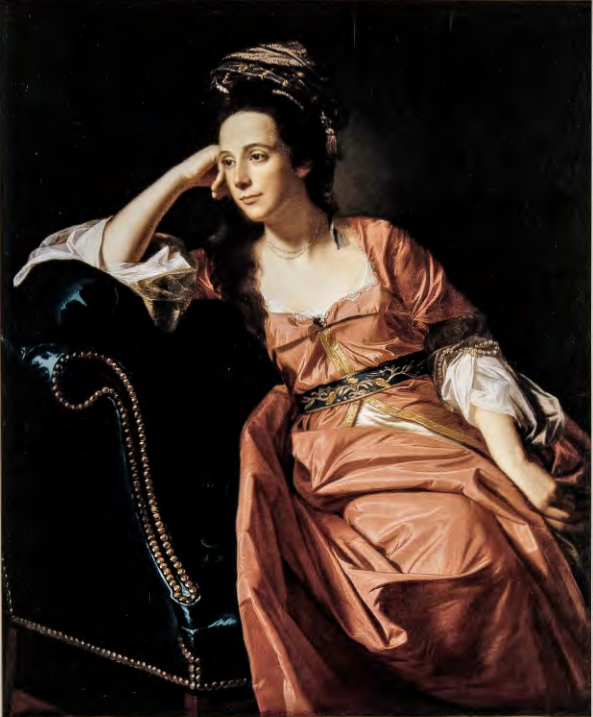
COPLEY'S COLONIAL PORTRAITS. Characteristic of Copley's achievement in America in the years leading up to the Revolution are his portraits of Nicholas Boylston (fig. 4.30) and Mrs. Thomas Gage (Margaret Kemble Gage) (fig. 4.31). Both appear in informal, indoor garb, appropriate for domestic pictures, but both also incorporate references to the much broader world. Boylston is pictured in a standard half-length canvas (that is, half the size of a canvas on which a full standing figure would be depicted), the size favored by Copley's patrons. Opulent textiles drape Boylston's table and the "window" behind his form. Ledgers and a distant ship bespeak his merchant identity; a velvet cap and silk clothing underline his prosperity. The robe that covers his clothes (it will be replaced by a fitted coat when he goes out) is called a banyan, a form derived from India, lending an exotic touch to the portrait.
A more complicated case of exotic costume is offered by the contemplative Margaret Kemble Gage, who is dressed in what was known as turquerie; that is, she wears a belted caftan over her uncorseted torso, and her loose hair is ornamented with pearls and a rich turban. This costume, so unlike the clothing Western women generally wore, derives from descriptions of Turkish culture and fashion included in the letters of an Englishwoman, Lady Mary Wortley Montagu. These detailed observations, widely circulated in her lifetime and published in London in 1763 after her death, were promptly republished in the colonies-an indication of the curiosity among colonial women concerning the material culture and social experience of their distant counterparts. Not just manifestations of a fad, such costuming ( on Mrs. Gage and the other eight women similarly attired in Copley portraits) alerts us to an empathetic interest among Copley's sitters in different cultures and alternative ways of being in the world. Margaret Gage was an American woman of Greek extraction who was deeply sympathetic to the Revolutionary cause but married to a British general. Her pose suggests a complex, but not easily decodable, discourse about dependence and independence, resistance and submission. Certainly her turquerie represents a kind of fictionalizing disguise, one that reads-together with her pensive posture-as eloquent of a thoughtful inner life. On both Boylston and Gage the cloaks of exoticism could simply (and superficially) be read as markers of wealth and an orientalizing turn of mind. But the portraits also suggest a more complex relationship between identity and costume, between here and elsewhere.
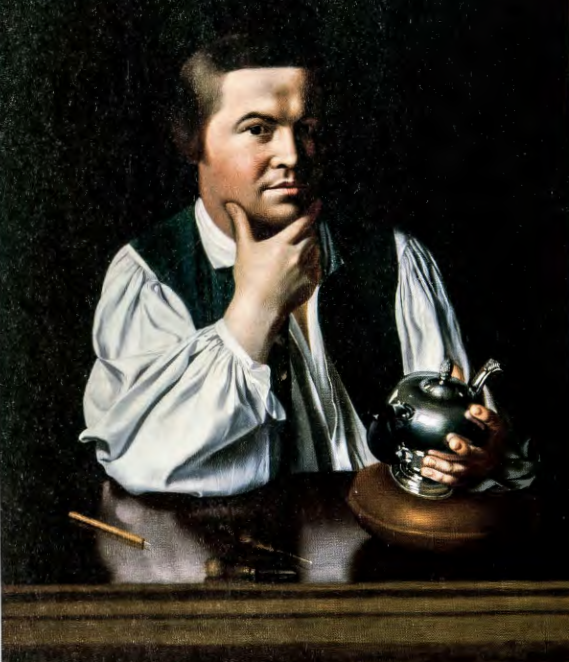
ln John Singleton Copley's Portrait of Paul Revere, 1768, the issue of clothing again comes to the fore (fig. 4.32). Revere cradles a teapot, which he is about to engrave with the tools on the table before him. Lacking the usual signs of gentlemanly status (wig, waistcoat, heraldic or family markers), Revere wears instead the blouse (or shirt) of an artisan. The fingernails of his left hand are dirty. He appears to pause in his labors, as if considering the next step in his work, or reflecting more generally on his craft. By picturing Revere as a thinker, as much as a maker, Copley suggests that Revere engages the world with his mind as well as his hands. His work requires thought and vision. Despite his work clothes, Revere behaves as an artist gentleman, someone whose contemplative pose suggests the intellectual habits of the upper classes. Copley's Portrait of Paul Revere is thus more than a portrait. The painting reveals Copley's own aspirations to high social status. It is a portrait of the artisan as artist. The teapot that Revere grasps forms an essential part of the portrait.
That teapot is not just an inverted pear-shaped object with a highly reflective serpentine surface. It is part of a burgeoning international economy of objects and cultural practices. It was made of silver from Mexico and fashioned in Boston to prepare tea-a drink brewed from leaves grown in Asia and sweetened with sugar cut in the Caribbean by African slaves. Thus one small teapot encompasses a global economy of ideas, foods, and people, as well as design.
WEST'S HISTORY PAINTINGS. For Benjamin West, as for Copley, the dilemma was how to achieve a purpose beyond the visual delight of mimicry and recording family history. Because the claims for painting as a gentlemanly occupation rested on intellectual and moral content, as well as on public exposure, the solution-for West-lay in London.
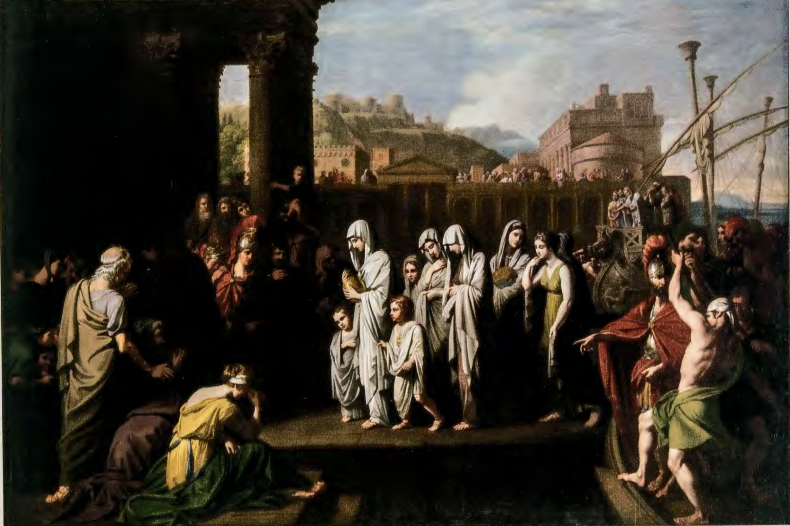
Benjamin West emigrated to Europe from his native Pennsylvania in 1759, at the age of twenty-one. He spent three years studying in Italy, and then established himself in London as a history painter and a portraitist. His first triumph was a history painting commissioned by the archbishop of York in 1768, Agrippina Landing at Brundisium with the Ashes of Germanicus (fig. 4.33). The subject, drawn from ancient history, pictures Agrippina, the widow of Germanicus, bringing her husband's ashes back to Rome in defiance of the emperor Tiberius. Germanicus had been a general with republican leanings; he stood next in line to become ruler of the empire. Instead, he was murdered. Cradling the funerary urn, Agrippina, together with her mourning children and attendants, disembarks at the port of Rome at Brundisium, modern Brindisi. She is a figure of popular sympathy. The image is simultaneously "chaste," in the frieze of central figures ( copied from a classical relief carving on the Ara Pacis in Rome), and robust, in the nearly nude mariner exerting himself in the right foreground. The urn that Agrippina holds represents, in miniature, the values that the artist most desired in painting: it contains not only the ashes of Germanicus but also the memory of classical virtue that he embodied and that she enacted. It bears witness to civilization's most cherished ideals. West's painting made the past immediate for mid eighteenth-century Londoners and prompted contemplation of honor, resilience, and public virtue. We see in this work the essential ingredients of history painting: high seriousness, large-scale narratives of death and sacrifice drawn from well-known texts and histories, the incorporation of visual quotations, and meditations on the struggle between wickedness and virtue.
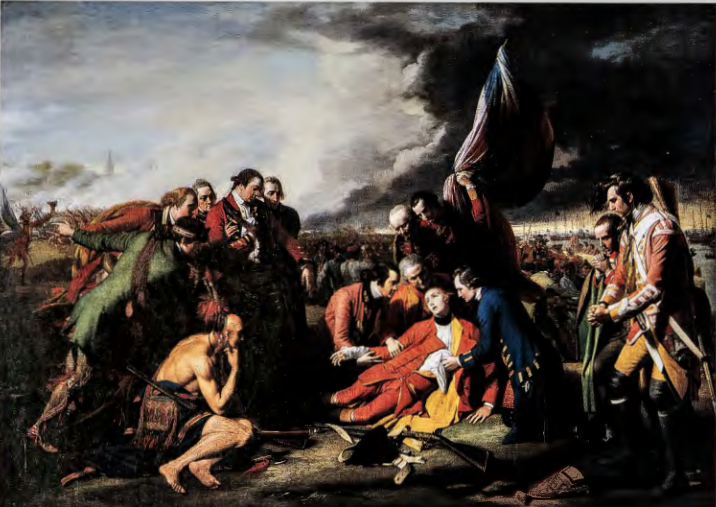
West's most important work, The Death of General Wolfe, 1770, exhibited at the newly founded Royal Academy in 1771, introduced Londoners to the idea of modern costume and modern events in history painting; it also rendered explicit the ideal of self-sacrifice for one's country (fig. 4.34). The painting resulted in West being appointed history painter to the king. The Death of General Wolfe pictures an event in the French and Indian War when, in 1759, British forces achieved a victory that resulted in the near elimination of the French empire in North America. During the Battle of Quebec the leading British general, James Wolfe, died from his wounds. Arranged in a tableau echoing a traditional "Descent from the Cross" or "Lamentation," the Christ-like Wolfe lies limp in the arms of his comrades. One officer swoons ( evoking the Virgin) into the arms of his companions. Central to this group is the Native American in the foreground. His heroic seminudity associates him with antique sculpture while his anthropologically correct accoutrements signal his status as an indigenous American. More than any other figure in the painting, this contemplative Indian conveys an understanding of the enormity of the event. For West's educated contemporaries, the painting's "moral" echoed the words of the Roman poet Horace, Dulce et decorum est pro patria mori ("It is sweet and honorable to die for one's country"). West's Mohawk warrior also reminded his British viewers that American colonials and their Indian allies had supported the British during the French and Indian War. Seated next to the figure of William Johnson, an American known for his work with Indians but not actually present at the battle for Quebec (Johnson wears Indian leggings), this warrior demonstrates West's deep sympathy for colonial causes. Painted at a moment of high tension between Britain and the American colonies, West's image brings together Johnson and the Mohawk as embodiments of New World sympathy, naturalness, and virtue. West presented the colonists, and their Indian allies, as valued partners that the British could not afford to lose.
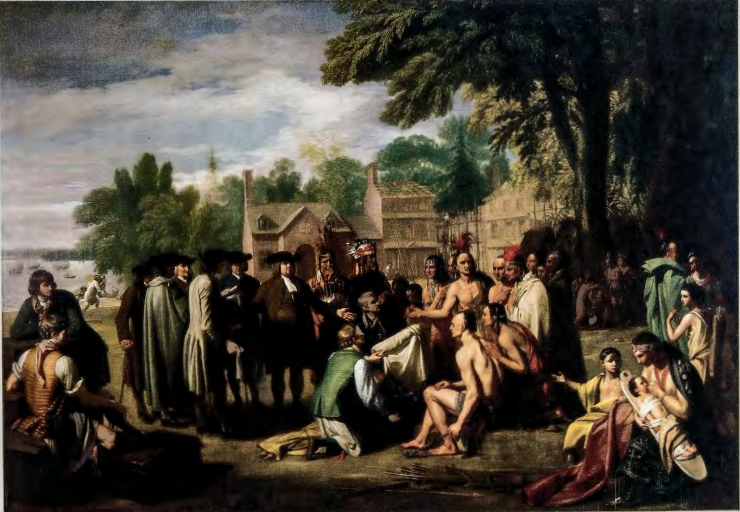
The following year, West again turned to history in order to comment on the present. In William Penn's Treaty with the Indians in 1683, 1771-72 , West commemorated an encounter in 1673 when William Penn, founder of the Pennsylvania colony, negotiated one of several land exchanges with the Leni-Lenape (Delaware) Indians (fig. 4.35). The French philosopher Voltaire would later describe Penn's treaty as the "only treaty" between Europeans and Indians that was "never infring'd." The painting divides into two halves: the lush and slightly darker world of the Native Americans on the right, and the ordered world of Penn and his circle of Quaker merchants on the left. At the center of the canvas, an unrolled bolt of cloth links the two parties. The viewer can barely see the text of Penn's treaty in the hands of the man to Penn's side. The painting focuses, instead, on the cream-colored cloth. Anthropologically, the cloth illustrates the process of diplomacy with Native tribes- the drawing up of a contract being followed by an exchange of goods, demonstrating the honorable intentions of both parties. At a political level, however, the cloth suggests something else. The fabric is linked visually to the trunk below it, to the second trunk in the lower left corner of the painting, and to the forces of commerce and trade associated with the harbor, ships, and sailors in the left background. The exchange between Penn and Natives becomes, in West's painting, a metaphor for fairness and mutual exchange between Old World and New: the portly and benign Penn and the colorful and animated Native Americans. The use of strong horizontal and vertical lines in the painting- in contrast with the dominant diagonals of The Death of General Wolfe-reinforces the painting's sense of equanimity and calm. Penn's fair dealings with his New World neighbors signal West's own hopes, in the years before the battles of Lexington and Concord, for just relations between the colonies and the Crown tied to commerce, consumption, and mutual respect. History, as we know, turned out differently.
Painting, Portraiture, and Race
Long before Benjamin West featured a Mohawk warrior in The Death of General Wolfe , African Americans had begun to appear in colonial portraits and group paintings. They were portrayed most often as slaves and servants, signs of their owner's wealth. By the time of the American Revolution, however, some painters, including John Singleton Copley, had begun to view the figure of the African American in a more sympathetic light. In this section, we shall examine the way colonial painters portrayed their African American subjects, and the reasons why Copley altered that equation.
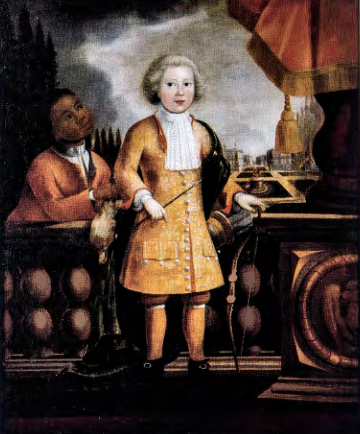
JUSTUS KÜHN'S HENRY DARNALL Ill AS A CHILD. The earliest known portrait of an African American in colonial painting is Justus Kühn's Henry Darnall III as a Child, c. 17m (fig. 4.36). Kühn (d. 1717) was a German immigrant to the Annapolis area in the first decade of the eighteenth century. He offered his Maryland clients the fantasy of European-style grandeur. He portrayed Henry Darnall, son of one of Maryland's wealthiest families, as a young aristocrat of imperious mien. Darnall's world is defined by his possessions, from his richly embroidered jacket and flowing green tunic (an allusion to classical portraiture) to the idealized garden on the other side of the balustrade. No such garden existed in the colonies in 1710. The garden's tight geometry, instead, represents a fantasy of an ordered, stable, and hierarchical world linked to class privilege and property ownership.
Kühn thus takes a young provincial from the New World and portrays him as an assured member of a transatlantic aristocracy. Darnall's black slave, in turn, attends his master from behind and below, fenced by the balustrade. The silver shackle around his neck indicates his status as property. The artist seems less interested in the slave as a person than in his fine attire, concerned that the domestic slave of an elite family must appear outfitted for the role. Accordingly, as young Darnall sports the weapons of the hunt, amusing himself, as a young gentleman should, with leisurely and aristocratic pursuits, his slave admires him.
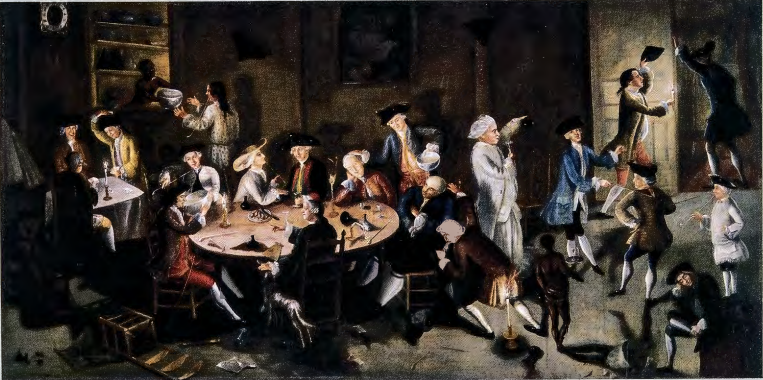
JOHN GREENWOOD'S SEA CAPTAINS CAROUSING AT SURINAM. African slaves appear in scenes of everyday life as well as in portraiture (see fig. 4.1). The earliest is a large genre painting (also called a subject picture), Sea Captains Carousing at Surinam, 1757-8, by a Boston-born painter and printmaker, John Greenwood (1727-92), who spent five years in Surinam, a Dutch colony on the northern coast of South America (fig. 4.37). A busy international entrepot, Surinam was frequented by traders from all round the Atlantic. Greenwood's painting, based loosely on a print by Hogarth, A Midnight Modern Conversation, 1733, that parodies excess drink, displays the bodies of the sea captains with an angularity that Hogarth, in his Analysis of Beauty, associates with ugliness, and with a lack of dignity that he associates with comedy. The only three figures exempt from the viewer's comic disdain are the three blacks-one hands a full punchbowl from the tavern's bar, another lies asleep in the left foreground, and the third, a boy, carries a salver with two glasses toward a pair of dancing men. This last figure, his near-nude body turning adroitly in space, evidences the steady hand of sobriety, even grace, in the sea of drunkenness through which he moves.
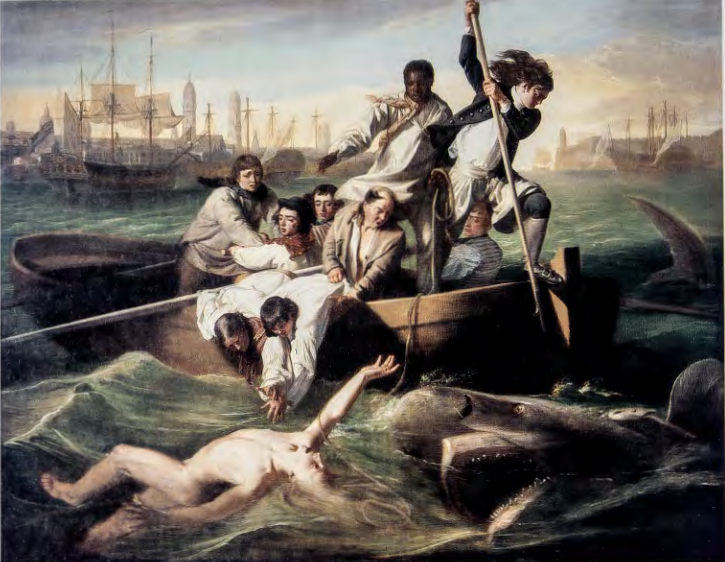
WATSON AND THE SHARK. John Singleton Copley similarly punctuates a scene of disorder with the graceful figure of a black man. Copley achieved one of his first public successes after emigrating to London when he exhibited Watson and the Shark (1776) at the Royal Academy (fig. 4.38). The painting expands the conventions of history painting by focusing on a personal incident in the life of Copley's patron Brook Watson, rather than on a scene of public virtue and sacrifice. The large scale and serious tone of Watson and the Shark re-create the moment when Watson, then a young man, lost a leg to a shark while swimming in Havana harbor. If Greenwood composed Sea Captains in terms of an eighteenth-century theory of comedy, then Copley invoked a different aesthetic theory of the time- the sublime-when painting Watson. Most memorably outlined by Edmund Burke in A Philosophical Enquiry into the Origin of Our Ideas of the Sublime and Beautiful (1757), this theory proposes that terror-from a safe aesthetic distance-can cause pleasure. Copley intends a visceral response to the shark-so huge and so close to both Watson and the viewer. The near-life-size rescuers in the boat display the emotions that the situation provokes in the viewer. The nude body of Watson is based on an antique sculpture known as the Borghese Warrior, here locked in deadly combat with a savage force of nature. For an educated audience, Watson and the Shark offered two pleasures: a feeling of sublime horror at Watson's situation, and the pleasure of recognition at Copley's classical allusion.
The art historian Albert Boime has interpreted Watson and the Shark as a political critique of the American Revolution. The painting draws attention to the hypocrisy of colonial claims to independence when such claims rest upon the continuance of slavery. The prominent position of the black man in the boat-one of only two figures standing-highlights the centrality of the slave trade to mercantile interests throughout the Atlantic.
In an earlier sketch for Watson and the Shark, Copley had drawn a white sailor in the position that he later gave to the standing black man. Why Copley substituted the figure of the black man in the finished version is unclear. Brook Watson himself might have suggested the change, or might have described the scene to Copley as including a black man. What is important, however, is Copley's "editorial" control. He has placed the black man at the center of the triangle that visually organizes the figures in the boat. The man's outstretched right hand gestures to Watson in the waters below him. That gesture is repeated in reverse direction by Watson's own upward-reaching right hand. The painting thus binds together Watson and his black rescuer, a white body and a black man held together visually- and historically-by modes of interdependence that neither can avoid.
When Copley's painting was first exhibited in London in 1778, viewers expressed skepticism at the efforts of the black man to save Watson. They noted the lax quality of the rope dangling from his hands and the failure of Watson to grasp it. The painting appeared to reinforce, rather than challenge, contemporary racial assumptions. It placed the black man behind a white figure in a position appropriate to a dedicated servant, and it left the black man's role in the ultimate rescue of Watson ambiguous. Nevertheless, Copley has not only integrated a black man prominently into the painting's central drama, but endowed him with psychological depth and profound humanity. Highlights upon the man's forehead and beneath his right eye suggest inwardness and contemplation.
The painting's significance for us, then, lies in its combination of humanistic values and conservative politics. Copley opposes the secession of the British colonies. His criticism of demands for American independence hinges on a racial argument: that the people who proclaim their freedom are, hypocritically, the same people who maintain slavery. The more human Copley's black man appears to be, the more untenable the colonists' claims to freedom become. Copley thus produces an opening salvo in what will become a dissenting tradition of blacks being portrayed sympathetically by white artists.
Watson and the Shark summarizes many of the social complications pervading colonial culture in the years leading up to the American Revolution. The scene is located in Havana harbor, an outpost of the Spanish empire that functioned as a key stop in the slave trade of the eighteenth century. Ships left New England and the colonies for Africa. They traded rum for slaves, and then headed to Cuba and the West Indies, where they sold their African cargo for ·sugar and molasses, ingredients essential to the colonial economy. The painting thus draws together the transatlantic worlds of Europe and America in their mutual dependence upon enslaved labor from Africa. The painting also imagines its little world as a microcosm of the larger world: individuals from different classes (where differences in clothes denote differences in social rank) all work together under the direction of a single, upper middle-class man (the figure with the boat hook) in a hierarchy that sets white upper class over white working class, and both over black. And yet the painting does more than mark off the social and racial divisions of colonial society. By heroicizing its figures, and transforming an incident of commerce into a drama of salvation, the painter articulates a utopian vision of cooperation and interdependence that will take on new life in the following decade with the onset of the American Revolution.


